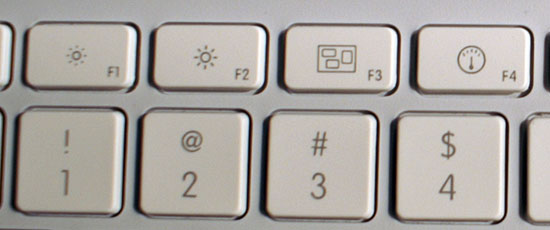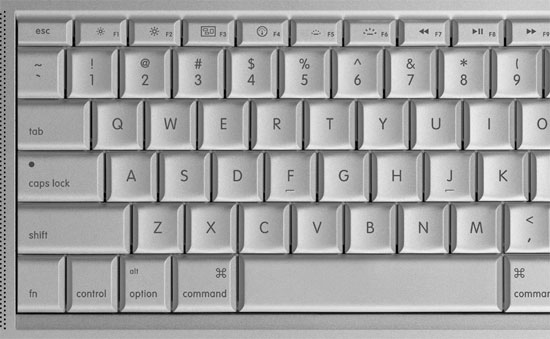Apple’s 45nm Refresh: New MacBook & MacBook Pro
by Anand Lal Shimpi on February 29, 2008 12:00 AM EST- Posted in
- Mac
Much Ado about L2
When Apple announced its Penryn upgrade clock speeds went up but in some cases L2 cache sizes went down. If you exclusively follow Apple hardware releases then changes in L2 cache size may be difficult to quantify in terms of performance impact, luckily we tend to be a little obsessed with CPUs at AnandTech so we can help clarify and, later, quantify.
Clock-for-clock, Penryn is between 0 - 10% faster than Merom across a variety of applications. On average Penryn is closer to 2 - 3% faster than Merom, at the same clock speed and that’s with a larger L2 cache. With the Penryn update, Apple bumped the clock speeds of all of its notebooks but in some cases reduced L2 cache size.
Intel offers two mobile Penryn cores: one with a 3MB L2 and one with a 6MB L2. Today’s applications, at least on the PC side, tend to fit very well within Merom’s 4MB L2 cache so you shouldn’t expect a significant performance increase, if any at all, from the larger L2 cache.
Back when Intel offered Core 2 CPUs with a 2MB L2 cache, we generally saw an 4 - 10% difference between them and the 4MB parts, averaging closer to 4%. Assuming performance scales linearly with cache size, the 3MB L2 chips should be marginally slower than the 4MB counterparts they replace. However, Apple didn’t just reduce L2 cache size, it also increased CPU clock speed at the same time. At the low end of the spectrum with the MacBook, the base configuration went from 2.0GHz to 2.1GHz, an increase of 5%. The 2.2GHz MacBook is now a 2.4GHz MacBook, an increase of 9%.
The MacBook Pro's base configuration also went from 2.2GHz to 2.4GHz (9% increase in CPU speed). By and large the increase in CPU clock speed should be able to erase any loss in performance from the smaller L2 cache, so we’d expect that at the same price point, the new MacBook and MacBook Pro CPUs won’t be any faster, but not any slower either.
Keyboard Updates
With the MacBook Air Apple introduced a revised keyboard with different function key mappings across the top. Historically, F9, F10 and F11 have been the Exposé keys; F9 Exposé-d across all windows, F10 did it to all windows in a single application and F11 moved all windows away revealing your desktop. OS X 10.4, Tiger, introduced the Dashboard, a great innovation that helped reduce window clutter by allowing for a separate desktop overlay with useful widgets. Apple mapped Dashboard to the F12 key.
The problem with using function keys on a notebook is that they are generally double-mapped. Hold down the fn key and they perform one task, otherwise they perform another.
It used to be that if you wanted access to the brightness, backlight and audio control buttons on the keyboard you had to disable the function-lock. Unfortunately if you did this, then you had to hold down the fn key whenever you wanted to access Exposé or the Dashboard. F3 and F4 are now dedicated Exposé and Dashboard keys, the point being that you can get the best of both worlds.

F3 is the Exposé key and F4 is the Dashboard key

Same on the MacBook Pro keyboard
Without fn-lock enabled, you can now use all of the keyboard hotkeys while also being able to Exposé all windows and view your Dashboard. Unfortunately the world isn’t perfect and I still like to be able to Exposé only a single application’s windows or just reveal my desktop, both of which still require the use of the fn-key (or enabling fn-lock). Unfortunately Apple has run out of fn keys at the top of the keyboard so it’s impossible to add these two additional Exposé functions without reducing functionality elsewhere.
I’m not sure what the solution to my problem is, but that’s for Apple to figure out, at best I can just complain about it.










51 Comments
View All Comments
tayhimself - Friday, February 29, 2008 - link
You also called the 2299 version 2199Doormat - Friday, February 29, 2008 - link
A quick question - the yonah Core Duos had really really poor battery life in the review. Were those performed recently with new batteries? The MB itself is nearly 2 years old.Still, 4 hours is amazing on the DVD tests. I could stop watching movies on my iPhone and use my laptop on the entire transcon flight... though I think I'll wait for the Montevina platform. Hopefully the SFF chips, 25W CPUs and additional graphics horsepower will be worth the upgrade.
alpaye - Friday, February 29, 2008 - link
Well it seems that these upgrades you call "tick upgrades" are mostly to keep up with the technology. They don't seem to be a must upgrade for people like me, as I own the last "tock version" of MBP. Nice review, good points.The Unofficial Mac (http://www.unofficialmac.com)">http://www.unofficialmac.com)
TestKing123 - Friday, February 29, 2008 - link
A comparison with non-Apple notebooks would be nice as well.AMDJunkie - Friday, February 29, 2008 - link
This is what I miss! Horribly cornball sex jokes (no point in calling it innuendo), genuine reporting of personal experience (shock at a kernel panic; admitting your exhausted because you've written a review at some godawful morning hour, for example), and snark (iWork is for converting your work into Office). And yet there's a half-decent review in there! It's like reading a blog, but with content!PlasmaBomb - Friday, February 29, 2008 - link
Tocks happen every two years not once a year...
Anand Lal Shimpi - Friday, February 29, 2008 - link
woops, that's what I meant :)Yearly tocks and I'm pretty sure we'd be well on our way to skynet by now :-P
Take care,
Anand
InternetGeek - Friday, February 29, 2008 - link
Apple will introduce a new 'revolutionary' Macbook in every tock, and some improved models on every tick. I wonder if Intel might be interested in having Apple use the 'Intel inside' logo? That'll be interesting.It'll be interesting to see how these MacBooks perform once some PC games are also ported to the Mac (Unreal and so)...
joey2264 - Friday, February 29, 2008 - link
The Macbook has an absolutely horrible keyboard. You can't possibly, rationally, reasonably, believe that this is not the case, especially with all your experience reviewing computers. The absolute crap Dell keyboards that they used to use in their notebooks are far better.I hope you mention somewhere in your review the ridiculousness of Apple releasing a 5.3 pound notebook with a 13.3 inch screen and integrated graphics.
Dennis Travis - Friday, February 29, 2008 - link
I have been using computers and almost every keyboard known to man from the Commodore 64 too todays keyboards find the keyboard on the Macbook and their external keyboard that is like the one in the Macbook two of the best I have ever typed on. I can fly on either of them.Keyboards are more of a personal thing as people are very different, but the Macbook has an excellent keyboard. Sorry I agree with Anand.